Learning to sew a straight stitch on a machine was a game-changer for me. It’s such a fundamental skill that opens up endless possibilities for creating your own projects. Whether you’re a beginner or just brushing up on your techniques, getting that perfect straight line can make all the difference.
Understanding the Straight Stitch
A straight stitch is the most basic and essential stitch in sewing. Mastering it ensures clean and professional results for various projects.
What Is a Straight Stitch?
A straight stitch creates parallel lines of thread that form a secure seam. It uses a single needle that moves up and down in a straight path, stitching fabric together evenly. This stitch is ideal for seams, topstitching, and basic garment construction. Most sewing machines default to a straight stitch, making it easy to select and use.
When to Use a Straight Stitch
Use a straight stitch for:
- Seaming: Joining fabric pieces in garments, curtains, and other sewing projects.
- Topstitching: Adding decorative lines or securing edges on quilts and apparel.
- Hemming: Creating clean and durable hems on clothing and linens.
- Repairing: Mending tears or holes with strong, straight lines.
- Constructing Projects: Building items like bags, cushions, and simple crafts that require sturdy seams.
By knowing when to apply a straight stitch, I ensure each project has the necessary strength and aesthetic appeal.
Preparing Your Sewing Machine
Before sewing a straight stitch, ensure your machine is properly prepared for optimal results.
Choosing the Right Needle and Thread
Selecting the appropriate needle and thread enhances stitch quality. I use a size 80/12 universal needle for most fabrics, balancing strength and flexibility. For delicate materials like silk, a fine needle minimizes snags. Pairing the needle with high-quality polyester thread ensures durability and smooth stitching. Verify compatibility by consulting your machine’s manual or manufacturer guidelines.
Setting the Stitch Length and Tension
Adjusting stitch length and tension ensures consistent, straight stitches. I set the stitch length to 2.5 mm, a standard for general sewing tasks. For heavier fabrics, increasing to 3 mm provides stronger seams. Tension affects thread balance; I typically start with a tension setting of 4. If stitches appear loose, increase the tension incrementally. Conversely, tighten the tension if threads loop on the fabric underside. Test adjustments on a scrap fabric to achieve optimal stitch appearance.
Step-by-Step Guide to Sewing a Straight Stitch
Sewing a straight stitch involves several precise steps to ensure clean and professional results. Follow these instructions to master the technique.
Threading the Machine
- Position the spool of thread on the spool pin.
- Guide the thread through the thread guide above the needle.
- Loop the thread under the tension disc.
- Insert the thread through the take-up lever.
- Thread the needle from front to back, leaving a tail of about four inches.
Starting Your Seam
- Place your fabric under the presser foot, aligning the edge with the marked guide.
- Lower the presser foot to hold the fabric in place.
- Hold the thread tails and gently press the foot pedal to begin sewing.
- Sew forward a few stitches, then reverse briefly to secure the seam.
- Continue sewing along the marked line, maintaining steady fabric movement.
Maintaining a Consistent Stitch
- Keep the fabric taut but not stretched as you sew.
- Adjust the stitch length if necessary for different fabrics.
- Monitor tension settings to prevent puckering or loose stitches.
- Use a consistent speed to ensure even stitch formation.
- Check regularly for any thread breaks or skipped stitches.
Troubleshooting Common Issues
Even when you’ve mastered sewing a straight stitch, you might encounter some common problems. Here’s how to address them effectively.
Preventing Stitch Breaks
Stitch breaks often result from improper threading or needle issues. First, ensure the machine is threaded correctly by following the threading path in your manual. Use a new needle, preferably size 80/12, and avoid applying excessive pressure on the needle. Additionally, check the bobbin tension and replace the thread if it’s tangled or low quality. Regularly cleaning your machine removes lint and debris that can interfere with the sewing process, helping to prevent stitch breaks.
Fixing Uneven Stitches
Uneven stitches can stem from inconsistent fabric feed or incorrect tension settings. Start by selecting the right needle size for your fabric type; a size too large or small can disrupt stitch uniformity. Adjust the tension setting, typically starting around 4, and test on scrap fabric. Ensure the presser foot is properly lowered and that the fabric moves smoothly under it. Regularly oiling your sewing machine can also enhance stitch consistency by allowing all moving parts to function seamlessly.
Tips for Perfecting Your Straight Stitch
Achieving a flawless straight stitch enhances your sewing projects’ professionalism and durability. Here are key tips to help you master this essential technique.
Practicing on Scrap Fabric
Practicing on scrap fabric builds confidence and refines your technique. Start with cotton or linen scraps, as they feed smoothly through the machine. Set your stitch length to 2.5 mm and use a size 80/12 universal needle with polyester thread. Sew straight lines, focusing on maintaining even tension and consistent fabric feed. Experiment with different fabrics to understand how each material affects stitch quality. Regular practice helps identify and correct issues like puckering or uneven stitches, ensuring precision in your actual projects.

Maintaining Your Sewing Machine
Proper maintenance ensures consistent stitch quality and prolongs your machine’s lifespan. Clean the machine after each use by removing lint and debris from the bobbin area and feed dogs. Oil the machine according to the manufacturer’s instructions, typically every 8-10 hours of use. Replace needles regularly—every 6 months or after 300 hours of sewing—to prevent skipped stitches and fabric damage. Check and adjust tension settings periodically, especially when switching fabric types. Storing the machine in a dust-free environment protects internal components, maintaining optimal performance and reliability.
Conclusion
Mastering the straight stitch has truly transformed the way I approach my sewing projects. Seeing those clean, consistent lines makes every piece I create feel polished and professional. It’s amazing how this simple stitch can make such a big difference in the overall look and durability of my work.
Keeping my machine well-maintained and practicing regularly has made sewing more enjoyable and less frustrating. Whenever I encounter a hiccup, I know how to troubleshoot and get back on track. Sewing is such a rewarding hobby and mastering the straight stitch is a solid foundation that keeps inspiring me to take on new and exciting projects.

















